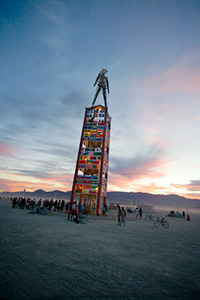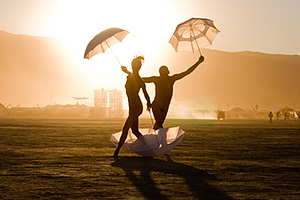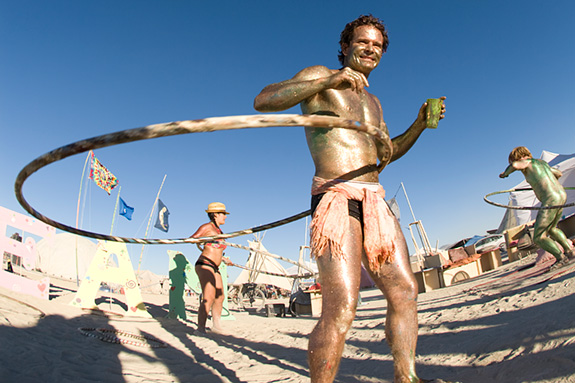Is It an Art Festival, a Desert Rave,
or a Visionary Social Experiment?
The Answer is Yes.
Photos and text by Scott London
Black Rock Desert, Nevada — Over the past two decades, the Burning Man festival has established itself as one of the world's hippest and most mind-blowing gatherings. Not quite an art festival, not quite a desert rave, not quite a social experiment, but something of all three, Burning Man is a week-long celebration of free-form creativity and radical self-expression held each summer in the remote Black Rock Desert of northern Nevada.
 The 2008 festival — which wrapped up here last week — drew close to 50,000 participants, many of them from far-flung locations across the United States and around the world. Despite high fuel costs and a deepening anxiety about the American economy, record numbers made the long trek out to the desert, many of them first-timers lured by accounts of ecstatic all-night parties, dazzling fire performances, offbeat and whimsical theme camps, startlingly decorated floats, pulsing soundscapes, enormous art installations, and, of course, the ritual burning of a 12-meter wooden effigy.
The 2008 festival — which wrapped up here last week — drew close to 50,000 participants, many of them from far-flung locations across the United States and around the world. Despite high fuel costs and a deepening anxiety about the American economy, record numbers made the long trek out to the desert, many of them first-timers lured by accounts of ecstatic all-night parties, dazzling fire performances, offbeat and whimsical theme camps, startlingly decorated floats, pulsing soundscapes, enormous art installations, and, of course, the ritual burning of a 12-meter wooden effigy.
Burning Man takes place in a sun-ravaged temporary city some 8 kilometers wide that rises out of the open desert each summer only to vanish again after the event is over. For a few brief days, the ephemeral metropolis known as Black Rock City ranks among the largest communities in the state of Nevada. It's a place of breathtaking diversity, a coming together of freethinking artists, dancers, performers, DJs, musicians, designers, hedonists, and exhibitionists of every stripe.
But Burning Man is more than just a week-long spectacle. As festival veterans are quick to point out, the festival is distinguished by a unique, perhaps even visionary, ethos. The rules of the game are radical self-reliance and creative self-expression.
 Burning Man attempts to invert many of the rules of normal society — most notably the exchange of money. Besides coffee and ice, there is no commerce of any kind at the event. Participants must bring everything needed for survival in the desert during the event, including water. And, in keeping with its strong environmental code of conduct, they must pack everything out and "leave no trace," returning the desert to its original pristine state by week's end.
Burning Man attempts to invert many of the rules of normal society — most notably the exchange of money. Besides coffee and ice, there is no commerce of any kind at the event. Participants must bring everything needed for survival in the desert during the event, including water. And, in keeping with its strong environmental code of conduct, they must pack everything out and "leave no trace," returning the desert to its original pristine state by week's end.
Participants are also urged to immerse and express themselves in some creative capacity — through making art, playing music, dressing up, walking on stilts, or simply being beautiful. Burning Man says, in effect, don't come unless you can contribute something fun, playful, glamorous, or intoxicating to the proceedings.
For many participants, it's a deeply transformative experience, one where they are encouraged to break out of the confines of old identities and express themselves in new and inventive ways. The result is a loosely structured event marked by a kind of unabashed creativity that is sometimes silly, often weird, occasionally brilliant, and always wildly entertaining.
A translation of this story ran in Dagbladet, Norway's leading daily newspaper, on September 10, 2008. For more of my images, see the Burning Man Photographs.

